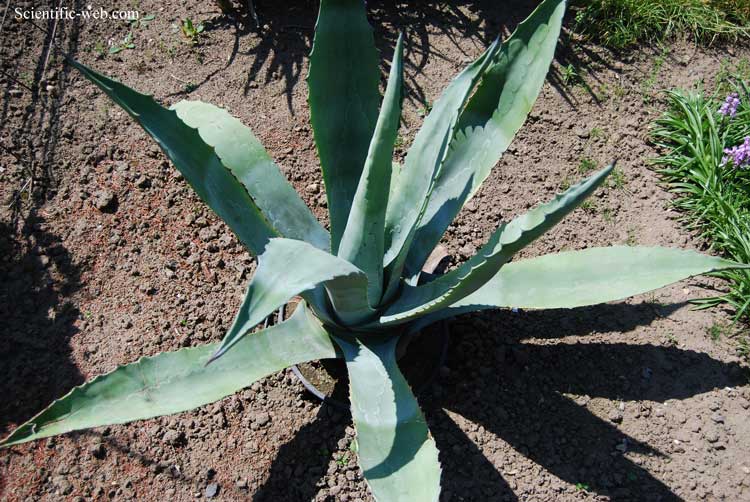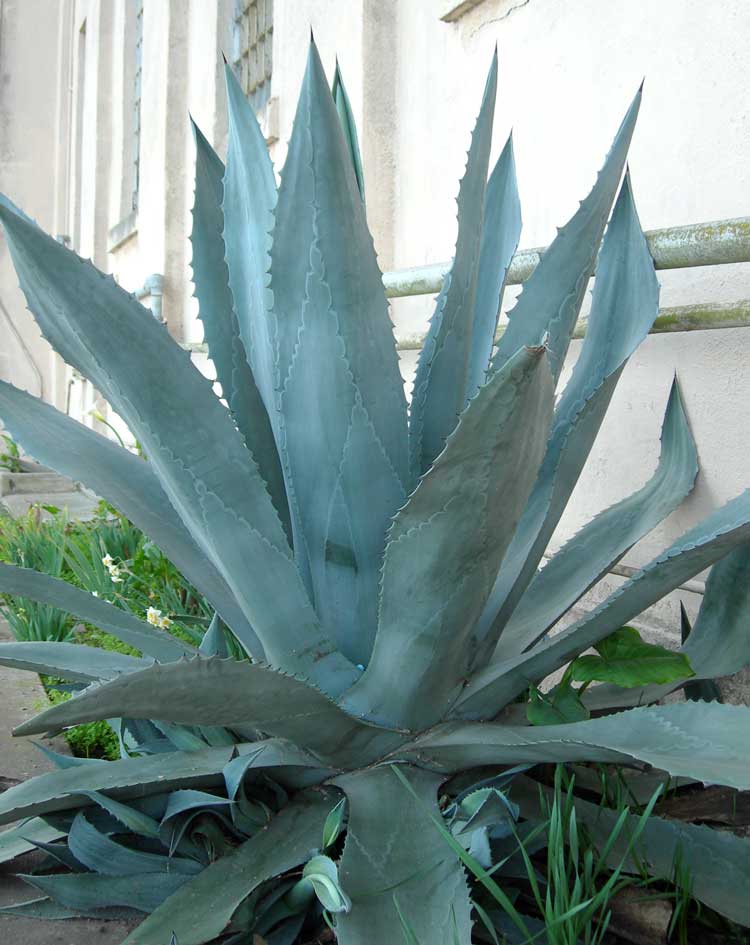
Agave americana, Photo: Michael Lahanas
Classification System: APG IV
Superregnum: Eukaryota
Regnum: Plantae
Cladus: Angiosperms
Cladus: Monocots
Ordo: Asparagales
Familia: Asparagaceae
Subfamilia: Agavoideae
Genus: Agave
Subgenus: A. subg. Agave
Sectio: A. sect. Agave
Species: Agave americana
Subspecies: A. a. subsp. americana – A. a. subsp. protamericana
Varietates: A. a. var. expansa – A. a. var. franzosinii – A. a. var. oaxacensis
Name
Agave americana L., Sp. Pl. 1: 323 (1753)
Synonyms
Homotypic
Aloe americana (L.) Crantz, Inst. Rei Herb. 1: 466 (1766).
Agave spectabilis Salisb., Prodr. Stirp. Chap. Allerton: 247 (1796), nom. superfl.
Distribution
Native distribution areas:
Continental: Europe
Regional: Southwestern Europe
Baleares, Corse, France, Portugal, Sardegna, Spain (introduced)
Regional: Southeastern Europe
Albania, Greece,itzerland.html">Switzerland, Italy, Kriti, Sicilia, Yugoslavia (introduced)
Continental: Africa
Regional: Northern Africa
Algeria, Libya, Morocco, Tunisia (introduced)
Regional: Macaronesia
Azores, Canary Islands, Madeira (introduced)
Regional: West Tropical Africa
Guinea (introduced)
Regional: West-Central Tropical Africa
Rwanda (introduced)
Regional: Northeast Tropical Africa
Chad, Eritrea, Ethiopia (introduced)
Regional: Southern Africa
Botswana, Cape Provinces, Lesotho, KwaZulu-Natal, Free State, Swaziland (introduced)
Regional: Middle Atlantic Ocean
Ascension, St. Helena (introduced)
Continental: Asia-Temperate
Regional: Western Asia
East Aegean Islands, Turkey (introduced)
Regional: China
China South-Central, China Southeast (introduced)
Regional: Eastern Asia
Korea, Nansei-shoto, Ogasawara-shoto (introduced)
Continental: Asia-Tropical
Regional: Indian Subcontinent
Bangladesh, India, Pakistan, West Himalaya (introduced)
Regional: Indo-China
Cambodia, Myanmar, Thailand (introduced)
Continental: Australasia
Regional: Australia
Norfolk Islands, New South Wales, Queensland (introduced)
Regional: New Zealand
New Zealand North, New Zealand South. (introduced)
Continental: Pacific
Regional: Southwestern Pacific
Fiji, Gilbert Islands, Nauru, New Caledonia. (introduced)
Regional: Northwestern Pacific
Marianas (introduced)
Continental: Northern America
Regional: Southwestern U.S.A.[1]
Arizona, California.
Regional: South-Central U.S.A.[1]
Texas.
Regional: Southeastern U.S.A.[1]
Florida, Louisiana.
Regional: Mexico
Mexico Central, Mexico Gulf, Mexico Northeast, Mexico Northwest, Mexico Southwest, Mexico Southeast (introduced).
Continental: Southern America
Regional: Central America
Costa Rica, Guatemala. (introduced)
Regional: Caribbean
Bermuda, Cayman Islands, Cuba, Dominican Republic, Haiti, Leeward Islands, Puerto Rico, Trinidad-Tobago, Windward Islands. (introduced)
Regional: Western South America
Bolivia, Colombia, Ecuador, Peru. (introduced)
Regional: Brazil
Brazil Southeast. (introduced)
Regional: Southern South America
Argentina Northeast, Juan Fernández Islands. (introduced)
Continental: Antarctic
Regional: Subantarctic Islands
Amsterdam-St. Paul Islands. (introduced)
PLANTS

Agave americana, Photo: nps.gov
----------
References: Brummitt, R.K. 2001. TDWG – World Geographical Scheme for Recording Plant Distributions, 2nd Edition
References
Primary references
Linnaeus, C. 1753. Species Plantarum. Tomus I: 323. Reference page.
Links
USDA NRCS PLANTS Profile
Govaerts, R. et al. 2019. Agave americana in World Checklist of Selected Plant Families. The Board of Trustees of the Royal Botanic Gardens, Kew. Published online. Accessed: 2019 Jan. 02. Reference page.
International Plant Names Index. 2019. Agave americana. Published online. Accessed: Jan. 02 2019.
The Plant List 2013. Agave americana in The Plant List Version 1.1. Published online. Accessed: 2019 Jan. 02.
Tropicos.org 2019. Agave americana. Missouri Botanical Garden. Published online. Accessed: 02 Jan. 2019.
GBIF.
Vernacular names
català: Atzavara
English: Century plant
español: Agave amarillo, pita
suomi: Jättiagaave
français: Agave américain
Gàidhlig: Àlas ceud bliadhna
magyar: Közönséges agávé, amerikai agávé
հայերեն: Ագավի ամերիկյան, պերճածաղիկ, զարմունի, շքուռ, հարյուրամյա հալվե
italiano: Agave
Nederlands: Honderdjarige aloë
polski: Agawa amerykańska
Runa Simi: Paqpa
Agave americana, common names century plant,[5] maguey, or American aloe,[6] is a species of flowering plant in the family Asparagaceae, native to Mexico and the United States in Texas. It is cultivated worldwide as an ornamental plant, and has been naturalized in many regions, including parts of the West Indies, South America, Mediterranean Basin, Africa, Canary Islands, India, China, Thailand, and Australia.[7]
Despite the common name "American aloe", it is not in the same family as aloe, though it is in the same order, Asparagales.
Blossoms of maguey agave
Description
'Marginata', a variegated cultivar
Agave americana 'Marginata'
Although it is called the century plant, it typically lives only 10 to 30 years. It has a spread around 1.8–3.0 m (6–10 ft) with gray-green leaves of 0.9–1.5 m (3–5 ft) long, each with a prickly margin and a heavy spike at the tip that can pierce deeply. Near the end of its life, the plant sends up a tall, branched stalk, laden with yellow blossoms, that may reach a total height up to 8–9 m (25–30 ft).
Its common name derives from its semelparous nature of flowering only once at the end of its long life. The plant dies after flowering, but produces adventitious shoots from the base, which continue its growth.[8]
Taxonomy and naming
A. americana was one of the many species described by Carl Linnaeus in the 1753 edition of Species Plantarum, with the binomial name that is still used today.[2]
Cultivation
A. americana is cultivated as an ornamental plant for the large dramatic form of mature plants—for modernist, drought-tolerant, and desert-style cactus gardens—among many planted settings. It is often used in hot climates and where drought conditions occur.[9] The plants can be evocative of 18th-19th-century Spanish colonial and Mexican provincial areas in the Southwestern United States, California, and xeric Mexico. It is also a popular landscape plant in dry beach gardens in Florida and coastal areas of the Southeastern United States.
When grown as a house plant, A. americana is tolerant of light levels ranging from direct sunlight to shade and requires little watering. It does require a winter resting period at temperatures around 10 to 12 °C (50 to 54 °F). It should be grown in a very porous, sandy potting soil, allowed to dry out between waterings, and repotted every spring.[10]
Subspecies and varieties
Two subspecies and two varieties of A. americana are recognized by the World Checklist of Selected Plant Families:[11]
A. americana subsp. americana
A. americana subsp. protamericana Gentry
A. americana var. expansa (Jacobi) Gentry
A. americana var. oaxacensis Gentry
A. americana var. marginata Trel. in L.H.Bailey, Stand. Cycl. Hort. 1: 235 (1914).
A. americana var. picta (Salm-Dyck) A.Terracc., Prim. Contr. Monogr. Agave (1885).
Cultivars include:[12][13]
'Marginata' agm[14] with yellow stripes along the margins of each leaf
'Mediopicta' agm[15] with a broad cream central stripe
'Mediopicta Alba' agm[16] with a central white band
'Mediopicta Aurea' with a central yellow band
'Striata' with multiple yellow to white stripes along the leaves
'Variegata' agm[17] with white edges on the leaves.
(those marked agm, as well as the parent species,[18] have gained the Royal Horticultural Society's Award of Garden Merit).
Uses
Tools used to obtain agave's ixtle fibers, at the Museo de Arte Popular, Mexico City, D.F.
Cuisine
If the flower stem is cut before flowering, a sweet liquid called aguamiel ("honey water") gathers in the hollowed heart of the plant. This can be fermented to produce the alcoholic drink called pulque. The leaves also yield fibers, known as pita, which are suitable for making rope, matting, or coarse cloth. They are also used for embroidery of leather in a technique known as piteado. Both pulque and maguey fiber were important to the economy of pre-Columbian Mexico, where the fermented drink was known as octli.[19]
In the tequila-producing regions of Mexico, agaves are called mezcales. The high-alcohol product of fermented agave distillation is called mezcal; A. americana is one of several agaves used for distillation. A mezcal called tequila is produced from Agave tequilana, commonly called "blue agave". The many different types of mezcal include some which may be flavored with the very pungent mezcal worm.[20] Mezcal and tequila, although also produced from agave plants, are different from pulque in their technique for extracting the sugars from the heart of the plant, and in that they are distilled spirits. In mezcal and tequila production, the sugars are extracted from the piñas (or hearts) by heating them in ovens, rather than by collecting aguamiel from the plant's cut stalk. Thus, if one were to distill pulque, it would not be a form of mezcal, but rather a different drink.[21]
Agaves are also found throughout Latin America, and are used similarly. In Ecuador, the analog of pulque is guarango, and more recently this has been distilled as miske.
Agave nectar is marketed as a natural form of sugar with a low glycemic index that is due to its high fructose content.[22]
Medicine
Agave americana contains agavose, a sugar with the same chemical formula of sucrose (C12H22O11[23]), but with only 0.32 of its sweetening power, as well as agavasaponins and agavosides.[24] It is used in traditional medicine to treat several ailments,[25] and as a laxative, diuretic and diaphoretic,[26] although a systematic review did not find enough data to support its effectiveness or safety.[27] A. americana is known to be able to cause severe allergic dermatitis.[28]
Heraldry
The plant figures in the coat of arms of Don Diego de Mendoza, a Native American governor of the village of Ajacuba, Hidalgo.[29]
Art
The Aztecs pulped the leaves of A. americana to create paper[19]—the Humboldt fragments were made in this way.[30]
See also
Purpuric agave dermatitis
References
García-Mendoza, A.J.; Sandoval-Gutiérrez, D.; Hernández Sandoval, L.; Zamudio, S. (2019). "Agave americana". IUCN Red List of Threatened Species. 2019: e.T13507070A13507074. doi:10.2305/IUCN.UK.2019-3.RLTS.T13507070A13507074.en. Retrieved 19 November 2021.
"Agave americana". Germplasm Resources Information Network (GRIN). Agricultural Research Service (ARS), United States Department of Agriculture (USDA). Retrieved 2010-01-12.
"Tropicos - Name - Agave americana L." www.tropicos.org. Retrieved 4 July 2017.
"Agave americana L. — The Plant List". www.theplantlist.org. Retrieved 4 July 2017.
BSBI List 2007 (xls). Botanical Society of Britain and Ireland. Archived from the original (xls) on 2015-06-26. Retrieved 2014-10-17.
Bailey, L.H.; Bailey, E.Z.; the staff of the Liberty Hyde Bailey Hortorium. 1976. Hortus third: A concise dictionary of plants cultivated in the United States and Canada. Macmillan, New York.
Irish, Gary (2000). Agaves, Yuccas, and Related Plants: A Gardener's Guide. Timber Press. pp. 94–97. ISBN 978-0-88192-442-8.
RHS A-Z encyclopedia of garden plants. United Kingdom: Dorling Kindersley. 2008. p. 1136. ISBN 978-1405332965.
"Agave americana (American century plant)". Native Plant Database. Retrieved 2013-06-11.
Chiusoli, Alessandro; Boriani, Luisa Maria (1986). Simon & Schuster's guide to houseplants. New York: Simon and Schuster. ISBN 0671631314.
Search for "Agave americana", "World Checklist of Selected Plant Families". Royal Botanic Gardens, Kew. Retrieved 2012-12-12.
Vermeulen, Nico. 1998. The Complete Encyclopedia of Container Plants, pp. 36-37. Netherlands: Rebo International. ISBN 90-366-1584-4
Royal Horticultural Society Database : Agave americana Archived December 1, 2011, at the Wayback Machine, retrieved 2011-07-28
"RHS Plant Selector - Agave americana 'Marginata'". Retrieved 2015-06-17.
"RHS Plant Selector - Agave americana 'Mediopicta'". Retrieved 23 February 2020.
"RHS Plant Selector - Agave americana 'Mediopicta Alba'". Retrieved 23 February 2020.
"RHS Plant Selector - Agave americana 'Variegata'". Retrieved 23 February 2020.
"RHS Plant Selector - Agave americana". Retrieved 23 February 2020.
Dr. Aguilar, Moreno (2006). Handbook to Life in the Aztec World. Los Angeles: California State University. pp. 371, 318. ISBN 0-8160-5673-0.
Hansen, Barbara (June 21, 2011). "Escamoles & Maguey Worms: John Sedlar on the Joy of Eating Bugs". L.A. Weekly.
Barbezat, Suzanne (2017-08-28). "Tequila, Mezcal and Pulque". TripSavvy. Retrieved 2018-07-25.
Oudhia, P. (2007). "Agave americana L." Plant Resources of Tropical Africa.
"Agavose". Merriam-Webster Dictionary.
"List of All Chemicals - Agave americana (Agavaceae)" (PDF).
Thomas H. Frederiksen (1997–2005). Aztec Medicine - Aztec Student Research Guide.
"Agave americana". Arizona State University.
"Agave (Agave americana): an evidence-based systematic review by the Natural Standard Research Collaboration". 2006. doi:10.1080/J157v06n02_09.
"Contact dermatitis from Agave americana". doi:10.1016/s0001-7310(05)73128-8.
pacbell.net/nelsnfam/mexico Archived July 6, 2008, at the Wayback Machine
Mason, William A. (1920). A History of the Art of Writing. The Macmillan co. p. 114.
Further reading
Brandes, Stanley. "Maguey". Encyclopedia of Mexico. Chicago: Fitzroy Dearborn 1997, pp. 767–769.
Gonçalves de Lima, Oswaldo. El maguey y el pulque en los códices mexicanos. Mexico City: Fondo de Cultura Económica 1956.
Payno, Manuel. Memoria sobre el maguey mexicano y sus diversos productos. Mexico City: Boix 1864.
Retrieved from "http://en.wikipedia.org/"
All text is available under the terms of the GNU Free Documentation License

